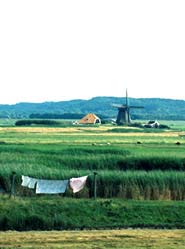Birds fly in the face of green farming incentive scheme

The Dutch government pays farmers to mow late and use less fertiliser. <br>© D. Kleijn <br>
European subsidies to enhance farmland wildlife may not be working.
The effectiveness of schemes that seek to promote biodiversity by paying farmers to cut back on intensive agriculture could be called into question by some research findings from Holland.
The incentive programmes, which already cost the European Union 1.7 billion euros (US$1.5 billion) each year and are rapidly expanding in scope, are partly motivated by the desire of European governments to subsidize farming without promoting the overproduction of food. But the programmes have been publicly justified by claims that they will help to restore ecological biodiversity on farmland.
In this issue of Nature, David Kleijn and colleagues at Wageningen University report results from one of the first schemes of this kind, operated by the Dutch government since 1981. They find that it has failed to significantly increase biodiversity in fields where farmers were paid to delay mowing or grazing, and to reduce the amount of fertilizer they used1.
The study did not examine how the total biodiversity in the region had changed over time, however. And EU officials and some conservationists are confident that the more sophisticated programmes now being implemented will yield increase biodiversity.
But many ecologists claim that such programmes have not been properly evaluated. “There are far too few studies of this kind,” says population biologist Arie van Noordwijk of the Netherlands Institute of Ecology’s Centre for Terrestrial Ecology in Heteren. “We have hardly any good data on the effectiveness of these programmes, and vast amounts of money are spent on them Europe-wide.”
Kleijn’s study counted species and numbers of plants, birds, bees and hoverflies in 78 fields last summer. Only bee and hoverfly diversity increased under the scheme. Birds actually seemed to prefer intensively farmed fields, possibly because reductions in fertilizer use lead to smaller invertebrate populations and so less food.
Kleijn thinks the study area is representative of intensively managed farmland across northern Europe, but admits that the effectiveness of such schemes in hill-farm regions, for example, may be quite different.
According to Carlos Martin-Novella, an official at the European Commission’s Development and Environment Unit in Brussels, the European Union has already adjusted its subsidy schemes to increase their effectiveness, and made arrangements to monitor them. For example, the commission’s biodiversity action plan, published earlier this year, requires member states to evaluate their agri-environment schemes. The new research “fits very well into this commitment”, says Martin-Novella.
David Gibbons, head of conservation science at the Royal Society for the Protection of Birds, a British conservation group, says that recent environmental subsidy schemes are designed with more scientific input than the Dutch study. Britain’s Arable Stewardship project, for example, which aims to restore farmland bird populations, expressly targets individual species. It will require farmers to leave stubble — an important food source for birds — in fields over the winter, instead of digging it up to plant crops such as winter wheat. The scheme is to be launched in 2002 after a three-year pilot study. “I’d be shocked if we don’t see real benefits over the next 5–10 years,” says Gibbons.
References
- Kleijn, D., Berendse, F. Smit, R. & Niels, G. Agri-environment schemes do not effectively protect biodiversity in Dutch agricultural landscapes. Nature 413, 723–725 (2001).
Media Contact
All latest news from the category: Ecology, The Environment and Conservation
This complex theme deals primarily with interactions between organisms and the environmental factors that impact them, but to a greater extent between individual inanimate environmental factors.
innovations-report offers informative reports and articles on topics such as climate protection, landscape conservation, ecological systems, wildlife and nature parks and ecosystem efficiency and balance.
Newest articles

Silicon Carbide Innovation Alliance to drive industrial-scale semiconductor work
Known for its ability to withstand extreme environments and high voltages, silicon carbide (SiC) is a semiconducting material made up of silicon and carbon atoms arranged into crystals that is…

New SPECT/CT technique shows impressive biomarker identification
…offers increased access for prostate cancer patients. A novel SPECT/CT acquisition method can accurately detect radiopharmaceutical biodistribution in a convenient manner for prostate cancer patients, opening the door for more…

How 3D printers can give robots a soft touch
Soft skin coverings and touch sensors have emerged as a promising feature for robots that are both safer and more intuitive for human interaction, but they are expensive and difficult…





















